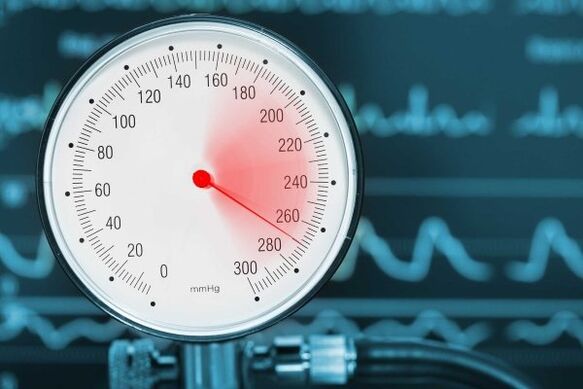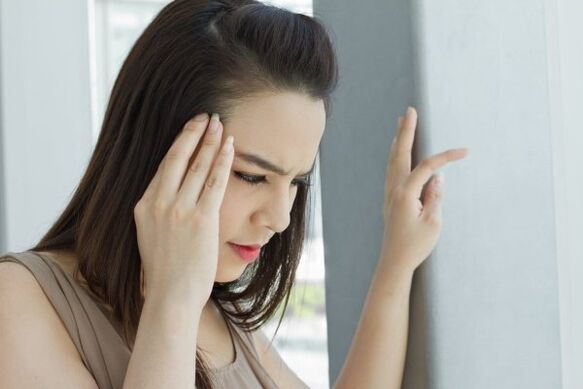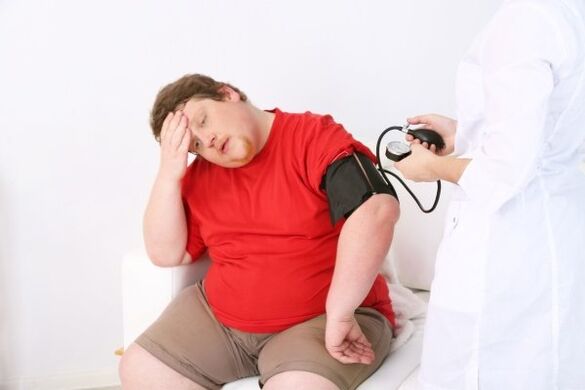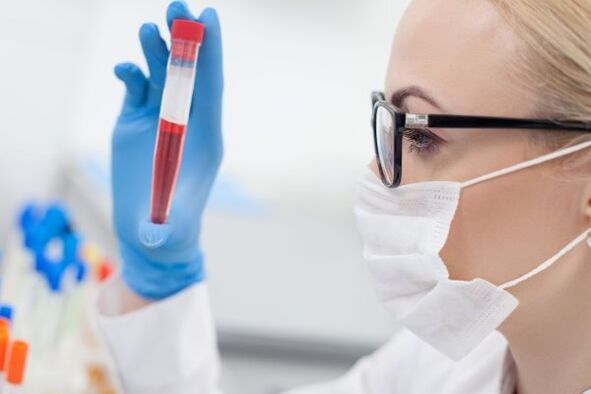Hypertension is a disease associated with a periodic or persistent increase in blood pressure (blood pressure).For some people, increased pressure is the norm, but this is an exception to the rules, and the indicators mentioned to most people are pathological.
Causes and mechanism of development of hypertension
In a healthy person, the pressure is normal about 120/80 mm Hg.Art.At the physiological and chemical level, increasing pressure is a natural reaction of the body to any risk or stress.In a critical situation, adrenaline is thrown into the blood, the heart begins to function faster, narrow vessels, the muscles contract and the pressure rises.

Regular stress, experiences, lack of sleep, problems - all this can lead to a chronic increase in pressure.However, doctors also call other causes of hypertension: inheritance, overweight or overweight, thyroid gland disorders, kidneys, magnesium deficiency in the body, taking some medications.
The pathogenesis of hypertension is not fully clarified.The hemodynamic base for increased blood pressure is an increased artery tone due to nerve impulses coming from the central nervous system along the sympathetic pathways.
In addition to the neurogenic mechanism, other mechanisms that increase blood pressure, in particular humoral, can also be ignited (sequentially) mood.
The renal factor associated with acute ischemia is also important.The inclusion of the renal factor contributes to the development of high and stable blood pressure.The well -known role in the complex pathogenetic mechanism of hypertension is played by the cortical layer of the adrenal gland.
Thus, two groups of factors can be distinguished in the mechanism for increasing blood pressure in hypertension: neurogenic, which have through the sympathetic nervous system a direct effect on the arterioles tone, and humoral, associated with enhanced secretion of catecholamines and some other active biological substances that cause a native effect.
The mechanism of development of hypertension is complicated.Many organs and systems are included in it.The degree of damage to different organs for hypertension can be uneven, therefore, some clinical and anatomical variants of hypertension are distinguished: with a predominant damage to the kidney, heart and brain vessels.
Symptoms
Arterial pressure is the blood pressure, which depends on the constant shocks of the heart that performs its pump function.It gives about 70-90 abbreviations per minute.By measuring blood pressure, we consider two digits: systolic pressure (at the time of contraction of the heart muscle) and diastolic pressure (at the time of its relaxation).Arterial hypertension is usually called a pressure increase above 140 by 90, respectively.
With increased pressure, a number of such features are usually observed:
- headache, ear noise;
- visual disorders;
- dizziness;
- Absent absence;
- Deterioration of memory;
- drowsiness;
- volatility of blood pressure;
- nausea;
- chills;
- Swelling of the eyelids, puffiness of the face in the morning;
- beating the heart of the heart;
- chills, sweating, pulsation in the head;
- facial redness, inner tension, anxiety, irritability;
- decrease in performance;
- swelling of the limbs, numbness of the fingers;
- Heart pain.
If any of these symptoms are observed occasionally, this is not a evidence of increased pressure.But if you notice the chronic presence of signs, consult a doctor.
The most common sign indicating the disease is headache.The second most important symptom of increased pressure are problems with visual perception:
- Hanging in the eye;
- The disappearance of objects;
- decrease in peripheral vision;
- periods of blindness;
- fog in front of my eyes;
- Reducing the reaction to the light.

Hypertension and hypertension: What is the difference?
Hypertension is a chronic disease with high prolonged and persistent blood pressure, and hypertension is a constant increase in blood pressure (ie, not a diagnosis, but body condition).In fact, these terms are one and the same, only the first indicates the name of the disease, and the second - the fact of increasing blood pressure is expressed.
Hypertension of hypertension is characterized by current features.While hypertension is an independent disease, arterial hypertension is a symptom of a pathological condition, which manifests precisely in a constant increase in pressure.
Thus, to say that this is one and the same thing, it is only possible in the case of a hypertensive crisis.The crisis itself is characterized by a continuous increase in pressure (hypertension) and at the same time occurs due to hypertension.
Stages of hypertension
For doctors for the correct diagnosis, it is necessary to determine the stage of hypertension in the patient and make a suitable record on his medical card.If hypertension is diagnosed in the patient late, that is, in stage 2 or 3, then the consequences for the patient's body will be more serious than if the onset of hypertension treatment in the first stage.However, few patients with hypertension at the initial stage are referred to a physician or at least regularly measures blood pressure.
First stage
140-150/90 mm Hg.Art.When arterial pressure fluctuates within these limits, the patient is diagnosed with the first (light) degree of hypertension.Hypertonic crises rarely occur, the disease is not minor.
The second phase
160-170/100-109 mm Hg.Art.- the second (moderate) degree of hypertension.Hypertonic crises are typical.The narrowing of the retinal arteries, the hypertrophy of the left ventricle is objectively recorded.
The third stage
200-300/129 mm Hg.Art.And above.Severe hypertensive crises (very severe form of hypertension) often develop.The harmful effect causes hypertensive encephalopathy, levo -atcentricular deficiency, development of brain vessels, hemorrhoids and optical nerve edema, and kidney failure, and kidney failure.
Why is hypertension dangerous?
Doctors argue that the consequences of hypertension are life threatening than AIDS, cancer and combined tuberculosis.The appearance of this disease is that its symptoms are similar to the signs of ordinary work.Therefore, about half of the hypertension for their illness will learn very late when it is very difficult to treat it and it is almost impossible to stop the processes of the destruction of the body that began.
The risk of hypertension is that it begins as a violation of blood pressure regulation functions, but in the future leads to many serious diseases of the organs and internal systems, especially in cardiovascular disease.A hypertension, which occurs without medical control, can lead to a heart attack, a heart growth and, ultimately, to the heart failure.
The consequences of hypertension are especially dangerous for those who have harmful factors for the murderous effect on the body of increasing blood pressure - smoking, alcohol, unhealthy eating, decreased lifestyle, frequent stress, high cholesterol levels in the body and diabetes.Such people increase the risk of heart attack, stroke and kidney failure, blindness and various cognitive disorders - reducing memory, intelligence and performance.

Hypertension is a 1 killer among all cardiovascular disease.Her mortality over the past 25 years has increased from 98 to 107 people to 100,000 people.This is a marked increase.50% of patients are treated very efficient, but only 10% reach the target level of blood pressure, that is, below 130 to 80.
Which doctor is engaged in treatment?
With added pressure, you have to go to a specialist.The therapist performs a prior examination of the patient, takes the necessary tests and determines which physician to return further.This feature is explained by the fact that the therapist is a specialist in some areas of medicine immediately.
After completing a prior inspection, the doctor issues a request for inspection of other specialists:
- neurologist;
- Cardiologist;
- nephrologist;
- Ophthalmologist;
- Endocrinologist.
Troubleshooting
The easiest diagnostic method is to measure blood pressure.If there is a steady growth at 140/90 mm Hg.Art.And above, that means there is hypertension.
Adult pressure is considered stable during repeated measurements (at least 2-3 times daily for 4 weeks).
The following diagnostic methods are also used to determine the presence of hypertension:
- urine analysis for protein and glucose;
- in hemoglobin or hematocrit;
- determination of creatinine level or an increase in nitrogen in the blood and urine;
- Glucose level during hunger;
- electrocardiogram;
- Heart ultrasound, kidneys;
- Consultation of an optometrist with a study of bloody lower vessels.
Measurement of blood pressure
Measuring blood pressure with a manual tonometer (Korotkov method):
- The tonometer cuff should be at the level of the heart (in the middle of the chest) 2 cm above the elbow.A finger should pass between the nemple and hand cuff.The cuff should cover at least 80% of the shoulder perimeter and at least 40% of its length.
- Place the phonondoscopy membrane at the shoulder artery pulse point.
- Quickly pump the air in cuff with a pear (remember to close the valve in advance) so that the air does not return to the upper pressure level, 20 mm Hg.Art.exceeding the systolic (by pulse extinction).
- Slowly release the air from a cuff at a speed of 2 mm Hg.Art.in sec.The first heard blow corresponds to the value of the upper pressure.The tone stop level corresponds to low pressure.If the tones are too weak, you need to raise your hand, bend and adjust it several times and repeat the measurement.
Blood and urine tests
A general blood test or urine test for hypertension will not be informative.It is impossible to determine the cause of the disease from such indicators, but they help to detect the stage of the disease.
From a general blood test, you can learn about the number of forms as well as evaluate the presence of inflammatory processes in the body.

Evaluation of heart work
There are several methods for evaluating heart work:
- Physical diagnosis involves the study of the heart muscle with the help of a phonondoscopy.The doctor "hears" in the heart, reveals noise, rhythm concern.Based on the results of physical diagnosis, ECG is described.
- ECG (electrocardiogram) is also an assessment of the work of the heart muscle, only more detailed.Such a study allows you to identify possible changes in time and fully analyze the heart work for a given period of time.
- Dopplerography is an effective ultrasound examination that helps determine the blood condition that passes through the vessels.
- Arteriography is a radiological method that evaluates the condition of the arterial walls, detects atheromatous plaques, arteries defects.
The last eye inspection
Eyes, like the heart, are considered a target organ with hypertension, therefore, when diagnosed with increased pressure, an eye is examined in the ifalmologist.As a rule, with hypertension, in the initial phase, retinal veins and narrowing of the artery are expanding.These functional changes are reversible: with normalization of pressure, blood vessels also return to normal.
In the second phase, organic changes occur, the situation deteriorates.Microanevrisms appear, hemorrhage can occur.
In the third stage, the condition of the optic nerve changes, the sharpness and the visual field deteriorate, the visual functions are interrupted.
ULTRASOUND
With kidney ultrasound and adrenal glands, kidney work is evaluated.Due to increased pressure on organs, nephrons die cells that filter daily blood liters from toxins.After all, this can lead to kidney failure.
An ultrasound of the kidneys helps identify volume formations in adrenal glands, severe renal tissue lesions.An ultrasound of renal arteries is also described.
How to treat hypertension?
Methods NO -DRGG:
- lowering body weight to normal;
- Refusal of smoking;
- lowering alcoholic beverages;
- moderate physical activity (regular walks in fresh air);
- decreased salt consumption;
- an increase in the diet of plant foods rich in calcium, magnesium and potassium;
- Reduction of consumption of animal fats.
Medicinal therapy is prescribed if non -valley methods have no effect, or the patient has risk factors for the development of diabetes, hypertensional crisis, kidney damage and coronary atherosclerosis.
drug
The development of hypertension medication has continued for more than a dozen years.But today, the problem of developing new, more effective and safe tools to reduce and control pressure is still acutely of medicine and pharmacology.
Today there is a wider variety of such medicines, but they all differ in the type of exposure, efficiency, indications and contraindications.Their cost plays an important role.Therefore, for each patient, the doctor chooses an individual scheme of treatment of hypertension medication, based largely on the causes of his occurrence:
- Diuretics.These medicines partially block calcium ducts, with a vasodilating effect.They are recommended if there are vascular disease at the same time as hypertension, but the tools are contraindicated for the people who have undergone myocardial infarction.
- ACE inhibitors (angiotensinzinoprofing enzyme).Lower the production of an enzyme that stimulates a decrease in vascular elasticity.They are very effective, well tolerated by patients with hypertension, favorably affect the cardiovascular system.They are often recommended after a myocardial infarction as well as increased pressure against the backdrop of diabetes.
- Beta-adrenosaers.Lower the heartbeat and reduce their strength.They have a wide range of application and are recommended for angina pectoris, tachycardia, after a heart attack, against the background of heart failure.
- Emergency pressure reducing medicines.This includes the mother's root extract, Valerian, Peony.
Diet
A special product for hypertension is baked potatoes.This product is rich in potassium-the most important trace element that regulates the metabolism of water salt in the body.
The main elements of food for hypertension are potassium, calcium, magnesium.It is these trace elements that greatly contribute to a decrease in blood pressure.
The diet for hypertension means rejecting fast food products, which are usually overloaded with sodium, and helps increase pressure.In addition, the diet should be saturated with products, also rich in calcium and magnesium:
- grain - bread, rice, wheat of solid varieties;
- dried fruits and leaf vegetables;
- low low meat and poultry;
- Retail products;
- Nuts and legumes.
Treat it very carefully with fatty foods as well as sweets.
Doctors claim that compliance with a diet helps maintain pressure within normal limits and thereby reduces the risk of stroke by nearly 40%, and heart attacks by 30%.
BE
All patients with blood pressure indicators are higher than 120-130 with 80-64 mm Hg.Art.You need to urgently change the familiar way of life and food for them.This consists in limiting smoking and drinking alcohol, proper compilation of a full related diet, physical exercises.
A healthy lifestyle for hypertension, as with any chronic disease, is one of the main factors of effective treatment.Therefore, changes are considered a critical step in the treatment process as well as preventing arterial hypertension.
Folk remedies
Most patients with hypertension take special medicines, but you can also fight the disease with the help of popular popular remedies.Consider some effective recipes:
- Flax seeds.They contain a large amount of omega-3 fatty acids.They contribute to an increase in the level of lipoproteins of increased blood density, which is a prevention of cholesterol growth and the formation of atherosclerotic complications in the vascular wall.The body cannot synthesize this substance itself, so it is important to ensure that it comes with food.In flax seeds, the amount of omega-3 is 25% of the weight plus they are relatively inexpensive and well absorbed.Take the linen seeds of 3 tablespoons a day in chopped form.
- Red pine cones tincture.It helps to normalize blood pressure and regulate post -post states.Tincture is prepared like this:
- Collect raw materials in the summer months, rinse under running water and pour into a liter jar;
- Pour vodka or alcohol 40 degrees, then place in a dark place;
- insist 2-3 weeks at room temperature;
- Before you start getting, strain through the gauze, doubled.
- Properly prepared tincture should be dark red.Take 3 times a day half an hour before meals in a teaspoon.You can mix with water or tea.
- Garlic.If you take garlic regularly, this stimulates the blood flow to the container, prevents deposition on their degradation walls of the oxidizing branch.The scrambled closed garlic features help to prevent blood clots.Continuous use of garlic carnations helps lower blood pressure by 7-8%.
- Two garlic teeth are thinly chopped and pour a glass of boiling water;
- Let it create 12 hours;
- In the morning, drink and prepare a new infusion.
- The course is a month.Take a glass twice a day.
- Lemon with blueberry and honey.Grate the lemon and mix the spoon with a tablespoon of blueberry.Add half a tablespoon of a fresh rose to the ground, a glass of honey and take a tablespoon of the product in the morning and evening.
- Plants.Take 4 tablespoons of crushed leaves of leaves.Pour a glass of vodka and let the makeup create for two weeks in a dark place.Stretch the mixture and use 30 drops three times a day.

You can also cook garlic infusion:
Predict
The prognosis for hypertension in the sense of absolute recovery is usually unfavorable.Only in the transistor phase is the complete interruption of further development of the possible disease.However, modern methods of treatment allow you to slow down the progression of the disease, prevent the development of complications, ease patients' condition, and maintain their ability to work for a long time.
The prediction for the renal variant of the course is very unfavorable, especially when kidney arteriolosclerosis develops.The forecast is exacerbated by the acceptance of atherosclerosis at any stage of hypertension.
Prevention measures for hypertension
Prevention of hypertension is divided into primary and secondary.Primary prevention needs healthy - those whose pressure does not yet exceed normal numbers.The complex of the healing measures below will help not only for many years to maintain normal pressure, but also to get rid of excess weight and significantly improve overall well -being:
- low -place diet;
- Restriction of animal fats;
- exercise;
- Psychological discharge;
- rejection of bad habits;
- Weight control.
Secondary masses are aimed at maintaining blood pressure within the rate in hypertensive patients, excluding hypertensional crises and preventing complications of the disease.Secondary prevention-including psychological training that contributes to moral and emotional discharge, physiotherapy procedures, treatment in sanatoriums, use of sedatives that improve sleep, use of traditional medicine (Hawthorn, Peony, Valerian, Motherwort) and daily control of pressure indicators.
If you pay attention to hypertension in a timely manner and start treating it, you can avoid serious consequences.Pressure problems are solved not only through medication, but to a greater extent due to a healthy and accurate lifestyle and control of their health.






















